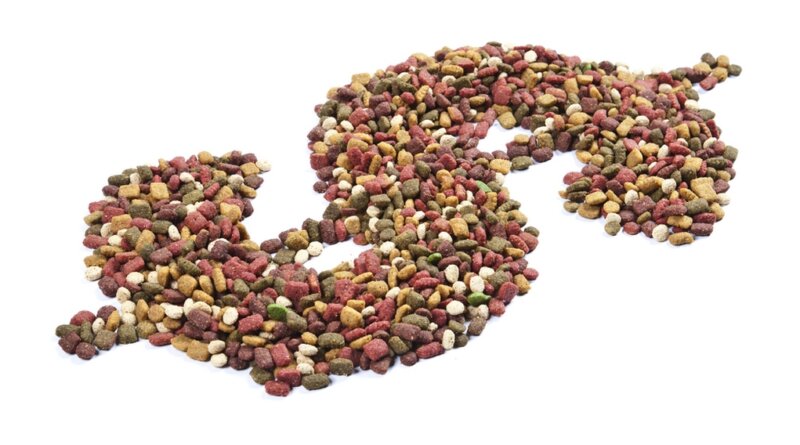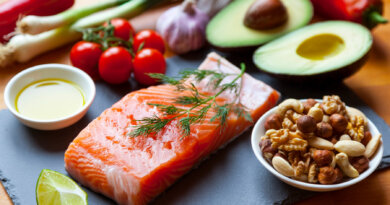Are They Worth the High Cost? – Top Dog Tips
With all the dog food commercials out there, it can be pretty confusing deciding what is the best food for your pup. Our options include all-natural food, probiotic food, food developed by chefs, food for fat dogs, food for skinny dogs; the list goes on and on, it never ends.
 On top of that, some of these dog food brands are so expensive that you begin to wonder: why? What’s the reason one dog food brand will cost three times more than the other? And is the higher price tag really worth it?
On top of that, some of these dog food brands are so expensive that you begin to wonder: why? What’s the reason one dog food brand will cost three times more than the other? And is the higher price tag really worth it?
Understanding dog food costs
Samantha recently asked this very same question of a pet food industry insider and they’ve discussed the costs of manufacturing pet food in this podcast episode: “Why Is Premium Dog Food So Expensive?”
By now, dog owners almost need a college degree to wade through all the dog food promos and find the best food brand for the money for their pets. I’m still dealing with this daily, after being a dog owner and pet content writer, researcher for over a decade. So while anyone can slap a “premium” or “best” sticker on their dog food, it is what’s inside that counts.
Today, there are literally hundreds of dog food brands available, which means it’s a headache to choose the right one. Personally, I’ve been doing the research on this for years, and these questions always popped into my head:
- Is expensive dog food truly better than cheap dog foods?
- Why do some dog foods cost twice, or even three times more?
- Who’s reviewing the actual value of these expensive dog food brands?
- How can I pick the best dog food brand in my own personal price range?
Over the last decade, there’s been a lot of research done on commercial pet foods and how they affect our dogs, why they cost as much as they do, and which ones are the safest for our canines. However, will all this information, many dog owners still struggle to find what exactly is best for their pets and how to feed them based on nutritional requirements.
Some dog foods are overpriced…

InsiderMonkey.com has researched the market and actually found THE most expensive dog food brands currently on the market. It’s interesting simply to take a look at what’s out there.
Apparently, some owners can afford this type of luxury for their pets. In fact, they don’t see any issues spending these amounts on their pets.
For example, this woman spends £27,000 every year on her dogs. That’s about $35,000 USD (post-Brexit rate). And this, of course, brings the question: is all of this worth it? Do these extremely expensive dog food brands justify their high cost, and should we even care about them?
In this article on expensive dog food brands, I am going to break down the science and hopefully make it easy for the average dog owner to pick a great dog food that will be affordable, but still, give your canine the nutrition he needs. I also want to break down the reasons why expensive dog food brands are better or worse for our dogs than inexpensive dog foods, and why that’s the case.
RECOMMENDED: The Best Dog Food for the Money: 17 Brands Worth Their Price (from Cheap to Costly)
Your Dog’s Nutritional Needs
The first thing to know when picking the best dog food is this: what are your dog’s nutritional needs and calorie requirements? A dog’s needs are not that different from human nutritional requirements. They include:
- Protein – 22% to 35% per serving – There are many diseases and disorders that can be caused by a lack of protein. Some signs that your dog is not getting enough protein are dry/brittle fur, lethargy from anemia, poor muscle mass, growth issues, and frequent illness from a weekend immune system.
- Healthy Fats – 10% to 40% per serving – You want to make sure he gets a food high in healthy fats. If your dog is not getting enough healthy fats, he can have a dull coat, dry/red eyes, dry/itchy skin, or joint problems.
- Carbohydrates – 5% to 15% per serving – Dogs need carbs for energy. The more active your dog is, the more energy he needs, thus the more carbs he needs. Vice versa, if your dog is lazy and sleeps a lot, the fewer carbs his body requires.
- Vitamins and Minerals – The amounts of vitamins and minerals that a dog needs vary. Most dog nutritionists agree, if a dog is eating a well-balanced food, then he is getting the vitamins and minerals he needs.
If you’re interested in finding out exactly where your dog falls in this nutritional range, for the most accurate information, do not try to find it through online articles. I recommend you schedule an appointment with your veterinarian or a canine nutritionist.
Using your dogs’ breed, weight, age, health history, and activity level along with other variables, they will be able to tell you the specific amount of each nutrient your pet needs and whether or not his diet should include any supplements.
Before you do, here are a few articles you’ll find useful on this topic:
Ingredients for Dog’s Nutritional Needs
How exactly do you meet all of your dog’s nutritional needs? There are a couple of ways. After you understand the reason behind feeding your dog specific nutrients and the basics of canine nutrition, you’ll know exactly whether expensive dog food brands are worth the cost or not.
So what about making your own homemade dog food meals?
Homemade dog food is also an option, as long as you ensure it’s nutritionally adequate for your pooch. The problem with most homemade dog foods, as studies have shown, is that they lack certain nutrients and dogs become malnourished. Make sure you get the best dog food recipes and add the required supplements for a complete meal.
Check out Samantha’s delicious dog food recipes with video instructions.
Some of her more popular homemade dog food recipes are these three:
I know, homemade dog foods are great for those with the time and money, but what about busy people, and dog owners on a budget? These owners can’t feed special supplemental items on special days, or work themselves ragged in the kitchen making food with only premium ingredients.
Nevertheless, more and more dog owners are turning to make their own homemade dog food. They use all the ingredients needed to make sure their pet is receiving proper nutrition, including:
- Protein – Dogs are omnivores, but their digestive systems process the nutrition of meats better than of grains. Beef, fish, and poultry are excellent sources of protein for your dog.
- Healthy Fats – You can get these from fish, sunflower oil, and chicken fat.
- Carbohydrates – Dogs get some carbs from meat and veggies. They can also get it from grains. Just remember dogs can’t digest grains as well as they can meats, so you have to cook their rice, potatoes, barley, etc until it is soft.
- Vegetables – Yep, dogs need vegetables, too. They can benefit from carrots, beets, sweet potatoes, peas, and many other vegetables. A good vegetable blend makes sure they are getting all the vitamins and minerals their bodies need.
As you can see, some items are listed under different categories. Like giving fish to dogs, which is an excellent source of protein and healthy fats. Dogs’ tastes are not as discerning, so you can get cheaper fish that is palatable to dogs but may not be so tasty for humans.
My uncle always fed his dogs a can of sardines every other day in addition to their regular dog food. But the smartest thing to do is go by the science, as well as consultations with your veterinarian. It only takes a little bit of initial research and time investment, and you don’t have to do that again afterward. The choice is yours.
RELATED: How Much Homemade Dog Food to Feed Your Dog
Reading Dog Food Labels

In other words, it doesn’t have to be true. “Natural” is as good as “Premium” and as good as “This Food is Bad for Your Dog” labels. They have no value.
The only ones regulated by the FDA, Food and Drug Administration (Pet Food Labels as per FDA) and USDA, United States Department of Agriculture (Organic pet food labels as per USDA) are the “Organic” dog food labels. This is good news for pet owners because you can be sure that organic dog food brands they purchase are actually organic.
Here are a few lists if you’re looking for them:
Ultimately, if you are buying prepackaged commercial dog food, you need to know how to read the labels. Organic dog foods are more expensive and not affordable for every pet owner, therefore, when buying cheaper brands that aren’t organic, be very skeptical and read those dog food labels.
I will now go over the basics of a label, but if you want more in-depth information, read this article on dog food label reading as well as visit the FDA’s article I linked to above.
1. Ingredients
The first thing you need to look at is the ingredient list. Dogs have a hard time digesting grains, and corn is the hardest for them. Many vets and nutritionists say not to get dog foods with corn at all.
These types of foods are usually expensive, so cost permitting, you should always try to feed foods where corn is not one of the first three ingredients. You want the food to have a variety of red meat, fish, poultry, vegetables, and grains.
If your dog eats grass, he may be missing some veggies. If he eats dirt, he may be missing some vitamins and minerals and needs more of a variety of ingredients in his food.
2. Additives
Dogs can have allergies just like people. You want to avoid foods that have artificial flavors and colors added. It may look and smell better to you, but that doesn’t make it better for your pet.
The fewer preservatives, and other additives, the fewer things to be allergic or sensitive to. You want the food to be as natural as possible, within your budget.
3. Nutrients
Dog food labels contain the percent of nutrients in a serving. For example, one dog food may contain 30% protein in a serving while another contains only 20% protein in a serving.
By reading and comparing labels you can see how much bang you are getting for your buck. Cheaper may not be a better value in the long run, and more expensive may not be better food.
Another important thing to remember is more is not always better. A dog can only benefit from a certain amount of protein, fat, vitamins, etc, and any more than that can actually cause health problems.
Why Dog Nutrition Is Important

Changes in diet can lead to diarrhea and vomiting. If you need to change foods, slowly mix in the new food with the old food so that the amount of old food decreases every day for a few days until it is no longer being fed at all. For this reason, it is best to find a dog food that has all the nutrition your pet needs in one package.
Dry vs Wet Dog Food
This has been extensively covered in one of the most recent podcasts with a pet nutrition specialist and Ph.D. in nutrition Dr. Adolphe – “Wet vs Dry Dog Food“. I recommend you listen to the podcast episode for the most in-depth information on the subject.
While some people think wet food is the way to go, and some think dry food is the best, what is on the label will tell you which dog food product you should choose for your Fido. Wet food contains water, so a serving may not contain as many nutrients, but dogs usually prefer the taste of wet food.
Dry dog food is condensed, so it may have more nutrients per serving. Some people prefer mixing wet and dry to get the best of both worlds. Many vets agree that younger dogs should have dry food for dental health, but older dogs need wet food due to teeth, gum, and digestion issues.
As with a lot of science, many canine researchers do not agree. They think that hard food does nothing for dental health. As long as your dog is eating and getting proper nutrition, the wet or dry aspect doesn’t matter much.
Here’s a list of 15 popular wet dog food brands and these are the most popular 25 dry dog food brands for most age stages.
Talking to Your Vet

You might be able to find dog food with the same ingredients for a better price at another retailer. You might even be able to find the exact same thing at another retailer for a lower price. So, while it is important to talk to your vet about specific nutrition needs your dog may have, do not feel pressured to buy the food for sale in their office.
Savings
Don’t forget, dog costs a lot, and when you have pets on a budget, make sure you are checking for savings. You can get coupons on manufacturer websites and couponing sites that make better quality foods close to the same price as lesser quality foods.
Also, many chain pet stores have rewards programs where you save and get coupons on the dog food brands that they sell. It may only be $1 here and there, but those savings will add up over time.
SOME TIPS: 25 Clever Tips on Shopping for Dog Food on a Tight Budget
Picks for Affordable Healthy Food
Now for my top picks of best dog foods based on ingredients, price, and user ratings, I’ve chosen these seven brands. Bear in mind, just because these are the foods I chose to feed my dogs doesn’t mean they will be the best choices for your dogs.
Again, remember to do thorough research and due diligence of your own before choosing any dog food brand – expensive or not – especially based on advice from online articles. Better yet, talk to your vet and make a good nutritional plan for your canine.
Newman’s Own Organics Grain-Free – These foods are primarily the meat your dog needs. They have no hard-to-digest grains. They contain other vegetables and ingredients to round out your dog’s nutrition as well. You can get it in dry or wet varieties. These foods are cheaper than most organic blends you will find, and the proceeds go to animal charities.
- Merrick – Merrick dog foods use top ingredients, including a variety of meats and vegetables that your dog needs. These foods are priced similarly to many brands you find in retail chain stores.
- Pure Balance – This is store-brand dog food. It is made by a major retailer. This means it has all the benefits of a more expensive food for a cheaper price.
-
Purina One – This is great food with great availability. It is sold at most chain retail and pet stores. It is made by a large pet company, so the prices are lower than that of smaller specialty food companies.
-
- Iams – This is another brand that can be found in almost any retail chain and pet store. The ingredients include chicken, beef, and vegetables. The popularity of this food helps keep costs down.
- Blue Buffalo – This is a higher-end brand, but it is widely sold in pet stores and some chain stores. It is rated very high with vets and customers alike. If you have a dog that doesn’t eat much, it may be worth looking into.
Hill’s Science Diet – This is the food a lot of my local vets carry. It has great ingredients. However, I can find it cheaper at some of the large chain pet stores in my area than it is at the vet’s office.
Next time you go to the pet store for dog food or choose to purchase your dog food online, remember that just because it is in the freezer section, says “raw foods” or “complete nutrition” or has the highest price tag, doesn’t mean it is truly the healthiest choice for your dog. Remember to read those dog food labels and make a proper assessment.
Another time-saving way of comparing is to go to dog food retailers, and big-box retailers, that have an online presence and you can compare dog foods in the comfort of your home. You can also search for coupons while you are online. Then just go to the store that has the food you want for the price you need.
READ NEXT: 80+ Ways to Save Money on Dog Expenses [Infographic]
Related










farmacie online sicure https://farmaciait.pro/ farmacia online migliore